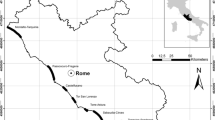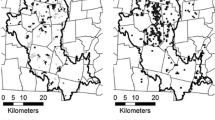Abstract
Landscape pattern might be an important determinant of non-native plant invasions because it encompasses components influencing the availability of non-native plant propagules and disturbance regimes. We aimed at exploring the relative role of patch and landscape characteristics, compared to those of habitat type and regional human influence on non-native plant species richness. For this purpose, we identified all non-native plant species in 295 patches of four coastal habitat types across three administrative regions in NE Spain differing in the degree of human influence. For each patch, we calculated several variables reflecting habitat patch geometry (size and shape), landscape composition (distribution of land-cover categories) and landscape configuration (arrangement of patches). The last two groups of variables were calculated at five different spatial extents. Landscape composition was by far the most important group of variables associated with non-native species richness. Natural areas close to diverse and urban landscapes had a high number of non-native species while surrounding agricultural areas could buffer this effect. Regional human influence was also strongly associated with non-native species richness while habitat type was the least important factor. Differences in sensitivity of landscape variables across spatial extents proved relevant, with 100 m being the most influential extent for most variables. These results suggest that landscape characteristics should be considered for performing explicit spatial risk analyses of plant invasions. Consequently, the management of invaded habitats should focus not only at the stand scale but also at the highly influential neighbouring landscape. Prior to incorporate landscape characteristics into management decisions, sensitivity analyses should be taken into account to avoid inconsistent variables.



Similar content being viewed by others
References
Atwood JP, Meyerson LA (2011) Island biogeography extends to small-scale habitats: low competitor density and richness on islands may drive trait variation in nonnative plants. Biol Invasions 13:2035–2043
Augustin NH, Mugglestone MA, Buckland ST (1996) An autologistic model for the spatial distribution of wildlife. J Appl Ecol 33:339–347
Bailey D, Billeter R, Aviron S, Schweiger O, Herzog F (2007) The influence of thematic resolution on metric selection for biodiversity monitoring in agricultural landscapes. Landscape Ecol 22:461–473
Baldwin DJB, Weaver K, Schnekenburger F, Perera AH (2004) Sensitivity of landscape pattern indices to input data characteristics on real landscapes: implications for their use in natural disturbance emulation. Landscape Ecol 19:255–271
Bartuszevige AM, Gorchov DL, Raab L (2006) The relative importance of landscape and community features in the invasion of an exotic shrub in a fragmented landscape. Ecography 29:213–222
Bolós O, Vigo J, Masalles RM, Ninot JM (1993) Flora Manual dels Països Catalans, 2nd edn. Pòrtic, Barcelona, Spain
Burnham KP, Anderson DR (2002) Model selection and multimodel inference: a practical information-theoretic approach, 2nd edn. Springer, New York, USA
Burnham KP, Anderson DR (2004) Multimodel inference: understanding AIC and BIC in model selection. Sociol Methods Res 33:261–304
Cadenasso ML, Pickett STA (2001) Effect of edge structure on the flux of species into forest interiors. Conserv Biol 15:91–97
Campos JA, Herrera M, Biurrun I, Loidi J (2004) The role of alien plants in the natural coastal vegetation in central-northern Spain. Biodivers Conserv 13:2275–2293
Carrete M, Grande JM, Tella JL, Sánchez-Zapata JA, Donázar JA, Díaz-Delgado R, Romo A (2007) Habitat, human pressure, and social behavior: partialling out factors affecting large-scale territory extinction in an endangered vulture. Biol Conserv 136:143–154
Catford JA, Vesk PA, White MD, Wintle BA (2011) Hotspots of plant invasion predicted by propagule pressure and ecosystem characteristics. Divers Distrib 17:1099–1110
Chytrý M, Jarošík V, Pyšek P, Hájek O, Knollová I, Tichý L, Danihelka J (2008a) Separating habitat invasibility by alien plants from the actual level of invasion. Ecology 89:1541–1553
Chytrý M, Maskell LC, Pino J, Pyšek P, Vilà M, Font X, Smart SM (2008b) Habitat invasions by alien plants: a quantitative comparison among Mediterranean, subcontinental and oceanic regions of Europe. J Appl Ecol 45:448–458
Chytrý M, Pyšek P, Wild J, Pino J, Maskell LC, Vilà M (2009) European map of alien plant invasions based on the quantitative assessment across habitats. Divers Distrib 15:98–107
Cully AC, Cully JF, Hiebert RD (2003) Invasion of exotic plant species in tallgrass prairie fragments. Conserv Biol 17:990–998
Deutschewitz K, Lausch A, Kühn I, Klotz S (2003) Native and alien plant species richness in relation to spatial heterogeneity on a regional scale in Germany. Global Ecol Biogeogr 12:299–311
Dormann C, McPherson JM, Araújo MB, Bivand R, Bolliger J, Carl G, Davies RG, Hirzel A, Jetz W, Daniel Kissling W, Kühn I, Ohlemüller R, Peres-Neto PR, Reineking B, Schröder B, Schurr MF, Wilson R (2007) Methods to account for spatial autocorrelation in the analysis of species distributional data: a review. Ecography 30:609–628
Elton C (1958) The ecology of invasions by animals and plants. Chapman & Hall, London, UK
Gassó N, Sol D, Pino J, Dana ED, Lloret F, Sanz-Elorza M, Sobrino E, Vilà M (2009) Exploring species attributes and site characteristics to assess plant invasions in Spain. Divers Distrib 15:50–58
Gassó N, Pino J, Font X, Vilà M (2012) Regional context affects native and alien plant species richness across habitat types. App Veg Sci 15:4–13
Gavier-Pizarro GI, Radeloff VC, Stewart SI, Huebner CD, Keuler NS (2010) Housing is positively associated with invasive exotic plant species richness in New England, USA. Ecol Appl 20:1913–1925
Gelman A, Hill J (2007) Data analysis using regression and multilevel/hierarchical models, 1st edn. Cambridge University Press, New York, USA
Grueber CE, Nakagawa S, Laws RJ, Jamieson IG (2011) Multimodel inference in ecology and evolution: challenges and solutions. J Evol Biol 24:699–711
Guirado M, Pino J, Roda F (2006) Understorey plant species richness and composition in metropolitan forest archipelagos: effects of forest size, adjacent land use and distance to the edge. Global Ecol Biogeogr 15:50–62
Hijmans RJ, Cameron SE, Parra JL, Jones PG, Jarvis A (2005) Very high resolution interpolated climate surfaces for global land areas. Int J Climatol 25:1965–1978
Hulme PE (2006) Beyond control: wider implications for the management of biological invasions. J Appl Ecol 43:835–847
Ibáñez I, Silander JA Jr, Allen JM, Treanor SA, Wilson A (2009) Identifying hotspots for plant invasions and forecasting focal points of further spread. J Appl Ecol 46:1219–1228
Khadari B, Grout C, Santoni S, Kjellberg F (2005) Contrasted genetic diversity and differentiation among Mediterranean populations of Ficus carica L.: a study using mtDNA RFLP. Genet Resour Crop Evol 52:97–109
Kueffer C, Daehler CC, Torres-Santana CW, Lavergne C, Meyer JY, Otto R, Silva L (2010) A global comparison of plant invasions on oceanic islands. Perspect Plant Ecol 12:145–161
Kumar S, Stohlgren TJ, Chong GW (2006) Spatial heterogeneity influences native and nonnative plant species richness. Ecology 87:3186–3199
Lonsdale WM (1999) Global patterns of plant invasions and the concept of invasibility. Ecology 80:1522–1536
Marini L, Gaston KJ, Prosser F, Hulme PE (2009) Contrasting response of native and alien plant species richness to environmental energy and human impact along alpine elevation gradients. Global Ecol Biogeogr 18:652–661
McDonald RI, Urban DL (2006) Edge effects on species composition and exotic species abundance in the North Carolina Piedmont. Biol Invasions 8:1049–1060
McGarigal K, Neel MC, Ene E (2002) FRAGSTATS 3.3: spatial pattern analysis program for categorical maps. Computer software program. University of Massachusetts Amherst
Milbau A, Stout JC, Graae BJ, Nijs I (2009) A hierarchical framework for integrating invasibility experiments incorporating different factors and spatial scales. Biol Invasions 11:941–950
Mood AM (1969) Macro-analysis of the American educational system. Oper Res 17:770–784
Ohlemüller R, Walker S, Bastow Wilson J (2006) Local vs regional factors as determinants of the invasibility of indigenous forest fragments by alien plant species. Oikos 112:493–501
Pauchard A, Shea K (2006) Integrating the study of non-native plant invasions across spatial scales. Biol Invasions 8:399–413
Pearson RG, Dawson TP, Liu C (2004) Modelling species distributions in Britain: a hierarchical integration of climate and land-cover data. Ecography 27:285–298
Pino J, Font X, Carbó J, Jové M, Pallarès L (2005) Large-scale correlates of alien plant invasion in Catalonia (NE of Spain). Biol Conserv 122:339–350
Pyšek P, Richardson DM (2006) The biogeography of naturalization in alien plants. J Biogeogr 33:2040–2050
Pyšek P, Jarošík V, Hulme PE, Kühn I, Wild J, Arianoutsou M, Bacher S, Chiron F, Didžiulis V, Essl F, Genovesi P, Gherardi F, Hejda M, Kark S, Lambdon PW, Desprez-Loustau M-L, Nentwig W, Pergl J, Poboljšaj K, Rabitsch W, Roques A, Roy DB, Shirley S, Solarz W, Vilà M, Winter M (2010) Disentangling the role of environmental and human pressures on biological invasions across Europe. Proc Natl Acad Sci USA 107(27):12157–12162
R Development Core Team (2009) R: a language and environment for statistical computing, version 2.9.2. Foundation for Statistical Computing, Vienna, Austria
Simberloff D (2009) The role of propagule pressure in biological invasions. Annu Rev Ecol Syst 40:81–102
Sobrino E, Sanz-Elorza M, Dana ED, González-Moreno A (2009) Invasibility of a coastal strip in NE Spain by alien plants. J Veg Sci 13:585–594
Steffan-Dewenter I, Münzenberg U, Tscharntke T (2001) Pollination, seed set and seed predation on a landscape scale. Proc R Soc Lond B 268:1685–1690
Sullivan JJ, Timmins SM, Williams PA (2005) Movement of exotic plants into coastal native forests from gardens in northern New Zealand. New Zeal J Ecol 29:1–10
Teo DHL, Tan HTW, Corlett RT, Wong CM, Lum SKY (2003) Continental rain forest fragments in Singapore resist invasion by exotic plants. J Biogeogr 30:305–310
Thuiller W, Slingsby JA, Privett SDJ, Cowling RM (2007) Stochastic species turnover and stable coexistence in a species-rich, fire-prone plant community. PLoS One 2:e938
Vilà M, Ibáñez I (2011) Plant invasions in the landscape. Landscape Ecol 26:461–472
Vilà M, Williamson M, Lonsdale M (2004) Competition experiments on alien weeds with crops: lessons for measuring plant invasion impact? Biol Invasions 6:59–69
Vilà M, Pino J, Font X (2007) Regional assessment of plant invasions across different habitat types. J Veg Sci 18:35–42
Vilà M, Pino J, Montero A, Font X (2010) Are island plant communities more invaded than their mainland counterparts? J Veg Sci 21:438–446
Westfall PH (1997) Multiple testing of general contrasts using logical constraints and correlations. J Am Stat Assoc 92:299–306
Yiming L, Zhengjun W, Duncan RP (2006) Why islands are easier to invade: human influences on bullfrog invasion in the Zhoushan archipelago and neighboring mainland China. Oecologia 148:129–136
Acknowledgments
We thank comments from two anonymous referees to a previous version of this manuscript. Research was funded by the Spanish Ministerio de Ciencia e Innovación projects Consolider-Ingenio MONTES (CSD2008-00040), RIXFUTUR (CGL2009-7515) and the Junta de Andalucía project RNM-4031.
Author information
Authors and Affiliations
Corresponding author
Electronic supplementary material
Below is the link to the electronic supplementary material.
Rights and permissions
About this article
Cite this article
González-Moreno, P., Pino, J., Carreras, D. et al. Quantifying the landscape influence on plant invasions in Mediterranean coastal habitats. Landscape Ecol 28, 891–903 (2013). https://doi.org/10.1007/s10980-013-9857-1
Received:
Accepted:
Published:
Issue Date:
DOI: https://doi.org/10.1007/s10980-013-9857-1




